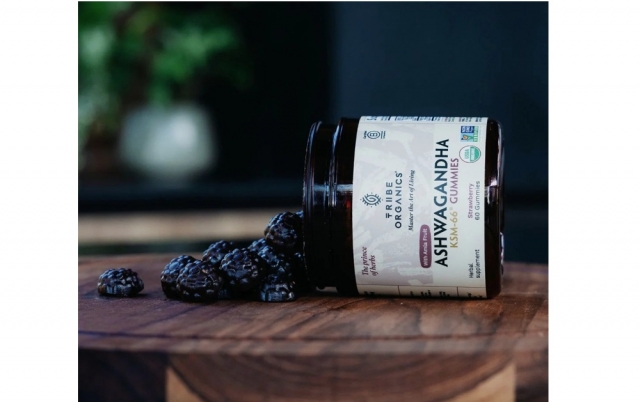Ashwagandha, also known as Withania somnifera, is a medicinal plant long revered in Ayurvedic practice. Referred to as the “Indian Ginseng,” it has been used for over 3,000 years as a rasayana - a category of therapeutic herbs believed to promote vitality and longevity. The roots of the plant are most commonly used, but leaves, seeds, berries, and stems also offer pharmacological value. Ashwagandha grows across drier regions of India, North Africa, and parts of the Middle East.
Modern research now explores this ancient herb’s biological activity in more detail. Compounds called withanolides, found abundantly in Ashwagandha’s roots and leaves, are at the core of its effects. These withanolides structurally resemble ginsenosides from Panax ginseng and interact with neurological, immune, and endocrine systems.
Its popularity today stems from its classification as an adaptogen - a substance proposed to help the body resist physical and psychological stress. It is sold globally in powder, capsule, and liquid extract forms, often marketed as a supplement for mental clarity, energy, and overall wellness.
What Does Ashwagandha Do?
The widespread interest in Ashwagandha is largely due to a growing body of scientific studies investigating its efficacy. The pharmacological effects are diverse: it has been studied for stress reduction, memory enhancement, anti-inflammatory action, immune support, and even its impact on neurodegenerative diseases.
Impact on Stress and Cortisol
Several randomized controlled trials suggest Ashwagandha has the potential to reduce cortisol levels - the primary stress hormone - through modulation of the hypothalamic-pituitary-adrenal (HPA) axis. Participants taking Ashwagandha extract reported reduced anxiety and improved sleep in clinical studies. These results are believed to stem from withanolides' interactions with neurotransmitter systems, particularly GABAergic pathways.
Table 1: Reported Effects of Ashwagandha on Stress-Related Outcomes
|
Study Model |
Mechanism Investigated |
Observed Effect |
|
Rodent (Chronic Stress) |
Corticosterone, immune, mood |
Reduced stress markers, improved mood |
|
Human RCT |
Serum cortisol levels |
22–30% reduction in cortisol |
|
In vitro |
GABA-mimetic effect |
Calming neurotransmission observed |
Neuroprotection and Cognitive Health
Withaferin A and withanolide D, two major withanolides, demonstrate neuroprotective effects in lab studies. In animal models, Ashwagandha has reversed oxidative damage, restored neurotransmitter balance, and improved behavioral performance in memory tasks. One proposed mechanism is the herb’s antioxidant influence - suppressing lipid peroxidation and enhancing superoxide dismutase (SOD) and glutathione peroxidase (GPx) activity.
Table 2: Antioxidant Markers After Ashwagandha Administration in Rodents
|
Marker |
Control Group |
Ashwagandha Group |
Significance (p-value) |
|
SOD activity |
85 units/mg |
123 units/mg |
p < 0.01 |
|
Glutathione (GSH) levels |
4.3 µmol/g |
6.7 µmol/g |
p < 0.05 |
|
Lipid peroxidation (MDA) |
3.1 nmol/g |
1.8 nmol/g |
p < 0.01 |
Mental Health and Neurological Conditions
Animal studies have shown Ashwagandha to possess anti-epileptic, anxiolytic, and antidepressant effects. These outcomes are largely linked to modulation of neurotransmitters such as GABA and acetylcholine. In some rodent trials, Ashwagandha reversed behavioral deficits caused by neurotoxins or stress paradigms.
Patients with Parkinson’s and Alzheimer's disease may also benefit from its neuroprotective action, though clinical data in humans remains limited. Ashwagandha has shown ability to protect dopamine-producing neurons and reduce oxidative stress markers relevant to Parkinsonian models.
How to Take Ashwagandha and What Works Best With It
Ashwagandha is most often consumed as a capsule or powder. Dosages commonly range from 300 mg to 600 mg per day in clinical settings, usually divided between morning and evening. Ideally as stomach friendly option, like Tribe Organics Gummies. Effects tend to build over several weeks rather than appearing immediately.
For general well-being or stress, low doses may suffice. For specific goals such as athletic recovery or memory enhancement, higher doses under supervision may be considered. It is best taken with meals to improve bioavailability and reduce the risk of gastrointestinal discomfort.
Final Thoughts
Ashwagandha continues to attract scientific interest not merely due to tradition, but because of a growing body of evidence that supports its effects on stress regulation, cognitive function, and neuroprotection. Its mechanisms are grounded in modulation of oxidative stress, neurotransmitter balance, and hormone levels. While most people can use it safely, its interaction with physiological systems demands thoughtful consideration.
Ashwagandha is not a miracle compound, but for individuals dealing with stress, fatigue, or cognitive fog, it may offer meaningful support. The strongest benefits are most evident in sustained, moderate use. As with any supplement, users should consult healthcare professionals, particularly when managing chronic conditions or concurrent medication use.
Whether used in the context of ancient practices or modern clinical regimens, Ashwagandha stands as a noteworthy example of how phytochemistry intersects with mental and physical health.






